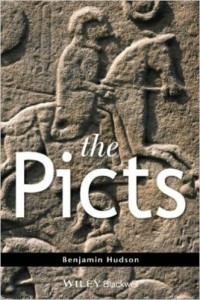Reviewer: Wouter van Dijk
The Picts, Benjamin Hudson
Wiley-Blackwell Publishers, Chichester 2014
ISBN: 978-1-118-60202-7
Paperback, with illustrations in black and white, tables, maps, list of abbreviations, select bibliography and index
266 pages
£24,99 / €33,80
The history of a half-forgotten people
After more than a thousand years after their disappearance from the historical record, the Picts continue to capture the imagination of many people. In his book Benjamin Hudson gives a scholarly overview of what is hitherto known about this mysterious folk from northern Britain. He places the Picts in the wider European context of developing and definable European peoples from Roman times well into the Middle Ages. The image of the Picts that is still dominant today, as Hudson points out, is one of a static monolithic culture, not changing at all in the approximately 500 years they were known. They were a warlike, savage people without knowledge of the script, hence the abundance of rock carvings. Hudson sets out to show that this image of the Picts is untenable. To do so, he describes in a concise but informative way all different aspects of the Pictish culture, art and religion and along the way discusses the most important historical debates that are currently going on.
In the introduction of the book Hudson discusses the most important primary sources that contain references to the Picts, such as Gildas’s Ruin of Britain and of course Bede’s Ecclesiastical History. Also, more recent vernacular sources are useful in revealing something of the Picts’ hidden history. The Y Gododdin poem, ascribed to the bard Aneirin and the Annals of Ulster and the Annals of Tigernach are examples of this vernacular literature. Hudson’s comparative approach proves very rewarding, for example in his view of the Picts as a ‘barbarian’ confederacy of tribes such as the Franks and Alemans were seen by the Romans. It is a pity Hudson doesn’t deliberate more on the worthiness of ancient and medieval writers as historians such as Gildas or Zosimus, but it is pleasant they get some attention, just as Bede does.
The author shows that the assumption of a single unified Pictish kingdom cannot be true; he rather tends to a construction in which two or more conglomerates of tribes, perhaps originally related to the ancient Pictones tribe from the western Atlantic seaboard. Also interesting is his treatment of the language, it seems originally Ogam was used by the Picts, and was later adopted by the Irish. Given the available evidence it seems at least some of the people described as ‘Picts’, the generic Roman term for all folk in northern Britain, actually were Britons. The people from the kingdom Gododdin for example, to the north of Hadrian’s Wall, described themselves as ‘Prydein’, simply translating as ‘Britons’ and relating to Welsh Prydain. Not entirely surprising, since it is known Britonnic kingdoms or Welsh if you like, kept contact with each other as they were put on the defensive by Irish and Germanic newcomers. Henceforth Taliesin’s poem Y Gododdin about his northern kinfolk.
Zooming out to take a look at the structure of the book, the first three chapters can be seen as context, describing the political situation and geography in which the Picts lived. The political situation in early medieval northern Britain was very fluid, with much warfare, alliance-building and –breaking and strife between rival dynasties. The career and empire-building of Angus son of Fergus in the eighth century seems to be a harbinger of the unification of Scotland by Kenneth I MacAlpin in the ninth.
While reading Hudson’s work not much misty and legendary remains of the people popularly known as ‘Picts’. He convincingly shows, as announced, the Pictish people from northern Britain had a lot in common with contemporary western European folks. Not only in their structure of society, but in ways to provide for their livelihood and in their religion. The ascent of Christianity in northern Britain for example, shows parallels with that of the communities in north-western Europe, although the Columban community played a less dominant role on the continent than it did among the Picts. On the way, Hudson also dispels some myths concerning the Picts. The assumption that they were illiterate for instance, since we now know the Picts did have books.
The author’s brief overview of Pictish art suffices in presenting the gripping and intriguing various art objects the Picts left behind. The position of Northumbria as a frequent ally of the Picts against Gaels and Vikings is also worth mentioning. After all, early medieval British history was not some simple affair of war between Britonnic kingdoms against Anglo-Saxon ones. As said, politics were fluid, and alliances were forged one moment and vanished the other. Of course also the final conquest and vanishing of the Pictish kingdoms is treated. Hudson discerns two main phases of fusion of the northern territories, one north of the Firth of Forth at the end of the eighth century, and one around the Moray Firth that was slightly earlier, in the first half of the eighth century. Some entries in the sources hint to the possibility the Scots were helped in the overpowering of the Pictish kingdoms by Viking raids in Pictish territory. It seems more plausible however, that there was no special attention for the Picts in case of Viking incursions. Anglo-Saxons, Britons and Gaels all were targets on a regular basis. The merging of the Scots and Pictish kingdoms was a gradual process that begun at least already in the eighth century by the establishment of the kingdom of Atholl. According to Hudson, the remarkability of the disappearance of the Pictish kingdoms is its unremarkability. In the contemporary annals hardly anything is mentioned that deals with the vanishing of these petty states.
The book’s last chapter is devoted to a historiographical exercise in which Hudson tells how remembrance of and thinking and writing about the Picts evolved from the Middle Ages onwards. This exercise completes a superb and comprehensive survey of what is currently known about the Picts. The book also contains a lucid summary, and will be useful for both scholars and the general public. Bringing to prominence the ordinariness and usualness of the Picts is Hudson’s greatest achievement. The bit his book helps in decomposing the aura of mysticism that surrounds the Picts brings us one step closer in understanding this early medieval people.
Wouter van Dijk
